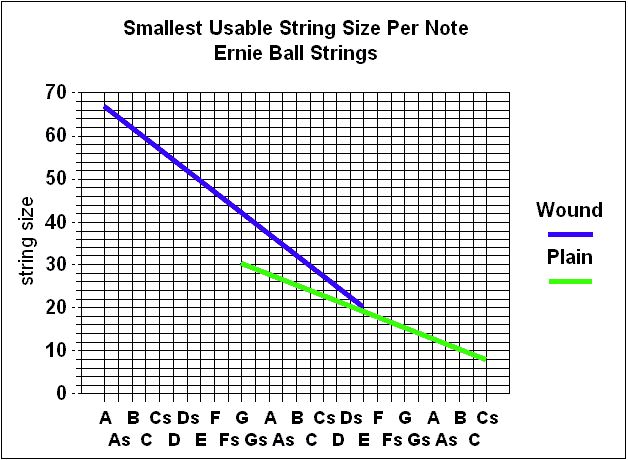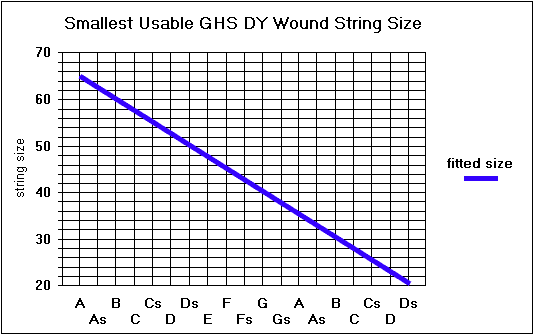
When I started to play, I asked around for how to choose the right guitar string for a given note. Nobody, not even the Ernie Ball Company, could tell me. Eventually I worked it out for myself, when I decided that I could afford to cut a fair number of strings to size in the 6-position to produce the necessary data.
First, here is what I found for Ernie Ball and GHS DY-series strings. But for the reasons below, these charts may not be exactly right for you. You may have to make up your own chart, and I will show you how.


As a guitar string is tightened, it goes through several phases. When it is too loose to function, it rattles. Then it starts to make notes when held to a fret, but the note depends on the depth to which it is pushed behind the fret. It is kind of rubbery. I think some people call this "slack key", and Ernie Ball calls it "slinky". Eventually, the string hold just one note when pressed to a fret, unless warped sideways. I use the last phase, because I do not have the finger control or skill to hit a note dead-on with a slack string.
The Smallest Usable String
To make these charts, I used 9 wound Ernie Ball strings from size 22 to 56, 12 plain Ernie Ball (EB) strings from 8 to 24, and 6 wound GHS DY strings from 26 to 53. So that I would be able to use them again, I wound them all, one at a time, on the 6-string tuner, using any appropriate path through the other tuners and slot in the nut. Then if I want to cut them shorter later for use in another string position, I can.
To relate strings to notes, I assigned 35 frets a value, starting from 0 for A below E in the standard E-A-D-G-B-E string setup. On each string, I tightened it until the first, or lowest usable note, that had no slackness, measured on a digital chromatic tuner, a Cherub (tm) Model WMT-555C. This gave me three tables of data, which I typed into Lotus 97 1-2-3 for the Ernie Ball strings and the GHS strings. I then ran regression analyses on each set to produce the fitted lines you see in the charts above. The standard errors for the Y (string size) estimate were 1.12 for EB wound strings (R-squared = 0.990), 1.41 for EB plain strings (R-squared = 0.926), and 0.73 for GHS strings (R-squared = 0.996). In other words, these are very good straight line fits.
Make Your Own Choices or Charts
If you think that these charts will work for you, use string and note combinations on or above the lines. That will give you either the lowest usable note for a string size, or the smallest usable string size for a given note. I chose DY-50, EB 38, 30 and 22 wound, and EB 13 plain strings for the 6 through 2 string positions, tuned G-C-E-G-C. These strings are tuned rather tight, but will allow me to tune about 2 to 4 frets lower if I want. My guitar runs about 25.5 inches from nut to bridge.
These charts may not work for you for several reasons, among them:
If so then you need to make your own charts. If you can't or don't want to use a computer spreadsheet like I did, a ruler and linear graph paper, even quadrille paper like the background on this page, will work just fine. Just draw a line through the points that looks like it is the closest to the most of them.